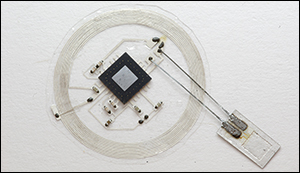Tiny electronic implants monitor brain injury, then melt away
22. 1. 2016 | University of Illinois at Urbana-Champaign | news.illinois.edu
A new class of small, thin electronic sensors can monitor temperature and pressure within the skull – crucial health parameters after a brain injury or surgery – then melt away when they are no longer needed, eliminating the need for additional surgery to remove the monitors and reducing the risk of infection and hemorrhage.
Similar sensors can be adapted for postoperative monitoring in other body systems as well, the researchers from University of Illinois at Urbana-Champaign and Washington University School of Medicine say. The researchers published their work in the journal Nature.

After a traumatic brain injury or brain surgery, it is crucial to monitor the patient for swelling and pressure on the brain. Current monitoring technology is bulky and invasive, Rogers said, and the wires restrict the patent’s movement and hamper physical therapy as they recover. Because they require continuous, hard-wired access into the head, such implants also carry the risk of allergic reactions, infection and hemorrhage, and even could exacerbate the inflammation they are meant to monitor.
The new devices incorporate dissolvable silicon technology developed by Rogers’ group. The sensors, smaller than a grain of rice, are built on extremely thin sheets of silicon – which are naturally biodegradable – that are configured to function normally for a few weeks, then dissolve away, completely and harmlessly, in the body’s own fluids.
Read more at University of Illinois at Urbana-Champaign
Image Credit: University of Illinois at Urbana-Champaign
-jk-




